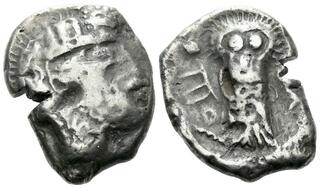| Naville Numismatics Ltd. > Auction 86 | Auction date: 17 December 2023 |
| Lot number: 183 Price realized: 900 GBP (Approx. 1,143 USD / 1,047 EUR) Note: Prices do not include buyer's fees. | Show similar lots on CoinArchives Find similar lots in upcoming auctions on |
| Lot description: Arabia, Kingdom of Ma'in (Minaia?) Uncertain mint Tetradrachm imitating Athens Circa 200-100 BC(?), AR 27.00 mm., 16.10 g. Helmeted head of Athena r. Rev. Owl standing facing, [olive sprig and crescent] behind; South Arabian letters z and ['ayin] to r. Huth, 'Monetary Circulation in South West Arabia' in CKK, Al-Jawf Hoard 21; cf. Roma e72, 626 (hammer: GBP 2,200). cf. Roma e73, 527. Very rare. Old cabinet tone and Very fine Ex Bertolami Fine Arts e-sale 109, 2022, 480. Martin Huth has argued that this series was struck on 'folded flans' which were prepared by hammering an existing coin to obliterate its design and then folding it once, then hammering together two such pieces before striking, resulting in a triangular shape (Huth, 'Monetary Circulation' in CKK, pp. 86-7). The Al-Jawf Hoard contained 21 tetradrachms struck on flans produced in this way and were found alongside numerous heavily bent Alexander III type tetradrachms (some Arabian imitations, see nos. 210-229 and 232-246). Huth suggests that the deformation of the Alexander III types may have been a way of invalidating coinage entering South Arabia, preventing its entry into local circulation and may have provided the raw material for new flans (ibid, p. 88). Despite this, Huth notes that the large size of the Alexander tetradrachms were not conducive to the method of production used to create the flans for the striking of the imitative Athens tetradrachms. The source material for flans used to strike this series of imitative Athens tetradrachms probably came from elsewhere and the exact reasons for this seemingly unnecessarily complicated method of production remain unclear. The likely burial date of the hoard is thought to be around the turn of the second century BC and the folded Alexander type tetradrachms date to the first half of the second century BC. This series of imitative Athens tetradrachms were probably produced around the same time the Alexander tetradrachms were circulating and the find spot suggests they were struck by one of the small states situated in the Wadi al-Jawf. Huth suggests the importance of the trading activities of Mai'in during this period, when other South Arabian states were minting their own coins, and its nature as a loose confederation of states make it a possible candidate for the attribution of this coinage (Ibid, p. 89). Martin Huth has argued that this series was struck on 'folded flans' which were prepared by hammering an existing coin to obliterate its design and then folding it once, then hammering together two such pieces before striking, resulting in a triangular shape (Huth, 'Monetary Circulation' in CKK, pp. 86-7). The Al-Jawf Hoard contained 21 tetradrachms struck on flans produced in this way and were found alongside numerous heavily bent Alexander III type tetradrachms (some Arabian imitations, see nos. 210-229 and 232-246). Huth suggests that the deformation of the Alexander III types may have been a way of invalidating coinage entering South Arabia, preventing its entry into local circulation and may have provided the raw material for new flans (ibid, p. 88). Despite this, Huth notes that the large size of the Alexander tetradrachms were not conducive to the method of production used to create the flans for the striking of the imitative Athens tetradrachms. The source material for flans used to strike this series of imitative Athens tetradrachms probably came from elsewhere and the exact reasons for this seemingly unnecessarily complicated method of production remain unclear. The likely burial date of the hoard is thought to be around the turn of the second century BC and the folded Alexander type tetradrachms date to the first half of the second century BC. This series of imitative Athens tetradrachms were probably produced around the same time the Alexander tetradrachms were circulating and the find spot suggests they were struck by one of the small states situated in the Wadi al-Jawf. Huth suggests the importance of the trading activities of Mai'in during this period, when other South Arabian states were minting their own coins, and its nature as a loose confederation of states make it a possible candidate for the attribution of this coinage (Ibid, p. 89). Starting price: 250 GBP |  |


